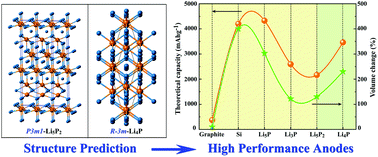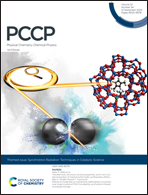Predicted stable Li5P2 and Li4P at ambient pressure: novel high-performance anodes for lithium-ion batteries†
Abstract
Lithium-rich phosphides have recently attracted considerable attention due to their potential application as high-capacity and high-rate anodes for lithium-ion batteries (LIBs). However, there is still short of the promising candidate thus far because of the poor electrical conductivity or huge volume change in the already known Li–P compounds. In this work, we report two novel Li–P states, Li5P2 and Li4P, stabilized under high pressures that are predicted to be quenchable down to ambient conditions by first-principles swarm structure calculations. The predicted P3m1 Li5P2 shows interesting features as a p-type semiconductor with an indirect band gap of 0.787 eV, possessing significant anisotropy properties in electrical transport, while R![[3 with combining macron]](https://www.rsc.org/images/entities/char_0033_0304.gif) m Li4P acts as a typical electride with metallic behavior at pressures of 0–82 GPa. More importantly, our calculations reveal that the theoretical capacities of Li5P2 and Li4P are predicted to reach 2164 and 3462 mA h g−1, respectively. Combined with the good electrical transport properties, the calculated volume expansion of Li5P2 (130%) is found to be much smaller than those of the previously reported Li–P compounds, indicating its potential as a high performance anode material for LIBs.
m Li4P acts as a typical electride with metallic behavior at pressures of 0–82 GPa. More importantly, our calculations reveal that the theoretical capacities of Li5P2 and Li4P are predicted to reach 2164 and 3462 mA h g−1, respectively. Combined with the good electrical transport properties, the calculated volume expansion of Li5P2 (130%) is found to be much smaller than those of the previously reported Li–P compounds, indicating its potential as a high performance anode material for LIBs.



 Please wait while we load your content...
Please wait while we load your content...